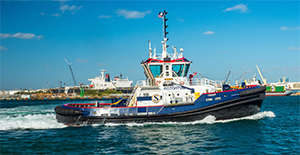Harbor tugboats with three z-drives were first introduced almost two decades ago. The first of these so-called Rotortugs has finally reached North American shores.
Seabulk Towing took delivery of Trident, the first of three planned Advanced Rotortugs (ART), in January. Master Boat Builders of Bayou La Batre, Ala., built the vessel using a design from Robert Allan Ltd. of Vancouver, B.C.
Seabulk assigned Trident — named for the weapon favored by the sea god Poseidon — to Port Everglades in Fort Lauderdale, Fla. The second tug, Triton, named after Poseidon’s messenger, is scheduled for delivery in late spring. A third tug, aptly named Trinity, is due in December.
“This was a proven design internationally, and we believed this concept could best service the growing LNG industry as well as accommodate the larger vessel sizes calling at our ports of operation,” said Rick Groen, COO of Seabulk Towing, a subsidiary of Seacor Holdings Inc.
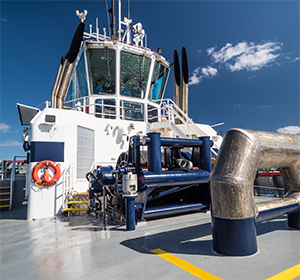 |
|
Seabulk outfitted Trident with a JonRie InterTech Series 500 double-drum stern winch. |
Naval architect Robert Allan, chairman of his namesake firm, considers the arrival of ART vessels in North America a potential game changer. “And I think it will make people stand up and take notice of what isn’t even a new development in the industry, but it will be a new development here.”
Robert Allan Ltd., under an exclusive agreement with Rotortug B.V. of the Netherlands, designed a series of ART triple z-drive vessels, which are typically defined by their bollard pull, length and, in the U.S., with the “US” suffix to distinguish them from the metric designations used everywhere else in the world. Hence, Trident is designated ART 80-98US due to its 80 tons of bollard pull and a 98.5-foot length. Allan estimates there are about 50 Rotortugs operating around the world.
“When the Rotortug concept was introduced, it was definitely a quantum shift in tug technology,” Allan said. “We claim no credit for that. It was developed and patented by Kotug, but we worked with them on the design of several project applications and introduced a number of design refinements. After working with them for a few years, they invited us to be the worldwide exclusive designer. That is our current role.”
The triangular arrangement of two z-drives forward and one drive aft provides increased omnidirectional maneuverability and control, as well as a great deal of propulsion redundancy.
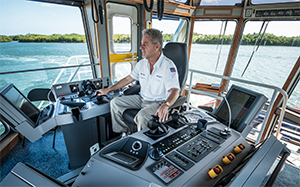 |
|
Trident Capt. Steve Rotert steering Trident, which features an Alphatron bridge console with JRC navigation electronics. |
“We liked the vessel redundancy the design provided, the dual towing system bow and stern, the additional drive unit so if one breaks down you’re not incapacitated, and the ability to run the boat as an ASD, true tractor (tug) or SDM,” said Groen. “We could lose a drive unit and still continue with the two units still functioning and have a bollard pull of 51 tons.”
The Rotortug, Groen added, can fit into spots and utilize the triangular drive configuration at angles not possible on an ASD tug. “When it comes to escort capability, the Rotortug design allows the operator to brake and steer simultaneously, whereas the ASD can only do one or the other when tethered.”
By March, Trident had proven her worth during some 40 docking and escorting assignments. During a demonstration run in Port Everglades, Capt. Steve Rotert explained that on a typical ASD or tractor tug, a skeg provides the hydrodynamic force used to steer a ship.
“In a Rotortug, the third thruster positioned aft provides for the same forces,” said Rotert. “Not having a skeg makes the vessel more maneuverable, allowing the vessel to sidestep easily. We do this at 8 knots. The configuration also makes for safer escorting, since the same force required to apply steering force to the escorted ship is applied by use of a thruster, not a hull appendage. If you lose any propulsion, the tug will simply fall in behind the ship and avoid tripping.”
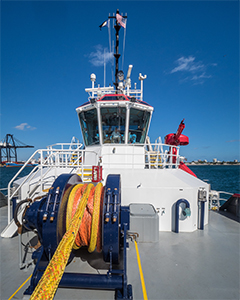 |
|
Trident has a JonRie InterTech Series 350 hawser winch installed forward of the house and a remote-controlled FFS monitor capable of 5,240 gpm |
It is also much easier to maintain control of the tug in the wake or bow wash of a ship. “The quick water is not catching the skeg and tossing (the tug) around,” Rotert said.
Utilizing the third drive in place of the skeg increases the tug’s overall maneuverability and sidestepping capabilities, explained James McCarthy, senior naval architect at Robert Allan Ltd. “The tug can go forward at 12.5 knots, backward at 12.5 knots, sideways at 8.5 knots and can turn on a dime,” he said. Under load, increased mobility provided by the third drive allows the tug to shift position easily when handling ships in tight spaces.
Another significant advantage, when called upon to fit longer ships into existing moorages, is “rotoring” — a maneuver where the tug operates within the beam limits of the ship. When rotoring, the tug’s wash is directed away from the ship, allowing for more efficient control while maneuvering the vessel. And the third drive on ART tugs allows them to perform effective sideways maneuvers in tight spaces where ASD tugs are constrained. Pushing athwartship, with the tug’s beam positioned onto the ship’s side, is one such situation.
While underway, Capt. Rotert steers the tug with the stern drive. “With the two forward units straight ahead, the aft unit is used as you would a tiller or single-screw boat. While working, the third unit is used to keep the stern of the tug at any angle you want. It allows you to sidestep at 8-plus knots, which will keep you from getting under the flare of a ship. When in indirect mode, it allows you to push with full power and still have full control of the tug.”
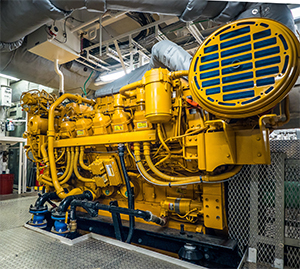 |
|
One of three Caterpillar 3512C engines installed on the 5,733-hp Trident. |
The introduction of a slip clutch allows the operator to maneuver the tug below 25 rpm. “It makes coming alongside a dock or docked ship very easy without a hard landing and generating a lot of prop wash,” said Rotert.
Propulsion for the three Rotortugs is provided by three Caterpillar 3512C Tier 3 diesel engines producing 1,911 hp each at 1,600 rpm. The mains drive Schottel SRP 1012 z-drives. Twin Caterpillar 150-kW gensets provide electrical power.
Trident’s wheelhouse, designed for maximum all-around visibility, offers a clear view of the tug’s fore and aft working areas. Rotert is no stranger to innovation. He was a captain on New River, the first Ship Docking Module (SDM) tug, delivered to Hvide Marine, now Seabulk Towing, in late 1997. He’s in his element explaining an array of sophisticated hardware and electronics populating the molded Alphatron integrated bridge system.
“The Alphatron system has four collapsible monitors that can be configured to each user’s preference.” For example, the radar can be put on any or all of the monitors, and the electronic charts can be displayed on either the forward or aft monitor, or both. The monitors feature touch-screen control of the tug’s lights, whistle, horn, monitor displays, window washers and wipers. The NUC, RAM, underway and towing astern lights have separate switches.
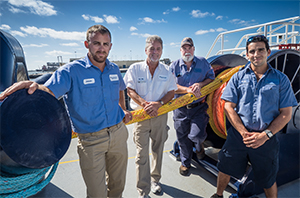 |
|
Trident will typically operate with four to six crew. Pictured from left are mate Jason Frongello, Capt. Steve Rotert, chief engineer Robert Santos and AB Gregory Schreiber. |
On deck is what JonRie InterTech President Brandon Durar considers a Tri-Winch set. The term describes a JonRie Series 230 hawser winch on the bow and a JonRie Series 500 double-drum winch on the stern. The bow winch and aft hawser drum are wound with 450 feet of Samson Saturn-12 8-inch HMPE rope. The stern winch towing drum is wound with 2,100 feet of 2.25-inch wire rope.
“The JonRie Tri-Winch set was designed for escort operation over the bow or from the stern and long-line towing over the stern, and makes the winch ideal for escorting, terminal support, towing and ship assist of the new containerships that come through the new Panama Canal expansion,” said Durar.
The JonRie foot pedal control is proving to be a popular feature. It allows hands-free operation of each winch. Operators press down to pay out and heal back to haul in.
“We are using the foot pedals exclusively as it frees up our hands to steer,” Rotert said. “The winches are working very well.”
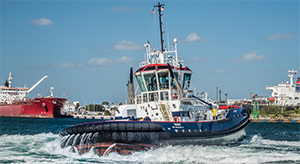 |
|
Trident shows her moves in the Port Everglades, Fla., turning basin. |
Trident is outfitted to a high standard with six crew berths. The master’s and chief engineer’s cabins are located in the deckhouse with two double-crew cabins located on the lower accommodation deck. A fully appointed mess/lounge and a nicely equipped galley are located in the deckhouse.
The conservative nature of the U.S. marine industry portends a cautious acceptance of the ART design. However, larger and larger ships calling at ports shrinking in size due to waterfront development may speed their adoption.
A couple of decades ago, tractor tugs and ASDs faced the scrutiny of industry conservatism. Once accepted, however, ASD tugs became standard across the industry. It could only be a matter of time before ARTs achieve similar acceptance.

